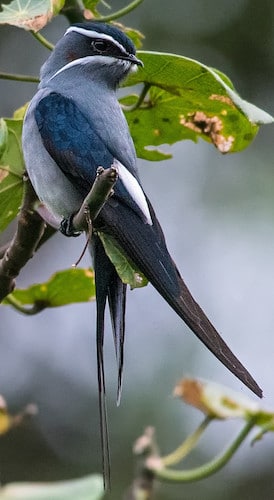Hemiprocnidae – Treeswifts

The Hemiprocnidae or Treeswifts are closely related to the typical swifts and together with the Hummingbirds form the superorder Apodimorphae. Unlike its celebrated close relatives this small family of just four species is comparatively unknown to all but the birding fraternity. Although they lack the extreme aerial adaptations of Swifts and Hummingbirds they are, nevertheless, a fascinating and stunningly beautiful quartet.
Three of the species, Crested, Grey-rumped and Whiskered, are restricted to Asia, with the fourth, Moustached, found from Sulawesi to New Guinea. All species are as likely to be encountered perched on overhead cables or bare branches on large trees as they are on the wing. However in flight when the long-scythe shaped wings and sharply pointed deeply forked tails become apparent there is no surprise to learn of their close relationship to the typical swifts.
Insect prey is always taken on the wing, either when sallying out from a perch in a Bee-eater like fashion or after more active swift-like pursuit whilst in the air. Their tiny bracket-shaped nests are remarkable structures. They are placed on the edge of horizontal branches and consist of papery bark scales and small feathers bound together with saliva. The nest is only big enough to contain a single egg and for extra protection this is adhered to the nest surface with saliva. This habit is shared with Palm Swifts.
Juvenile Tree-Swifts have astonishingly cryptic plumage and superficially resemble Cuckoos. The adults are the most strikingly plumaged members of the order Apodiformes. On plumage the family breaks into two pairs. Crested and Grey-rumped (who are indeed very closely related, constituting a superspecies, and were previously included within the same species) are varying shades of grey with reddish-orange ear-coverts. They both have erectile crests. The largest species, Moustached and the smallest Whiskered, have faces that are ornamented by two white whiskers above and below the eye. The plumage of the two differs with Moustached being varying shades of blue grey, with a white belly and vent, whilst Whiskered has a beautiful bronze body and white under-tail coverts. Male Moustached Treeswifts have an area on the ear-coverts which is brick-red and it is interesting to note that in the other species pair, reddish-orange ear-coverts are restricted to the males.
The best places to observe these species are forest clearings, especially those with convenient perches such as overhead power cables or, areas of water within forests or in mangroves. I fondly remember whilst swimming taking refuge from the heat of the day in a river pool at the legendary Gurney’s Pitta site in Peninsula Thailand whilst a Grey-rumped Swift repeatedly flew past us and eventually skimmed the waters surface to drink only a few feet from us. This happened on two successive days at midday. Typically the birds are most active at dusk when they can be surprisingly vocal, issuing long Parakeet-like chips and trills.
According to the IOC there are just four species, which are:
Crested Treeswift Hemiprocne coronata
Grey-rumped Treeswift Hemiprocne longipennis
Moustached Treeswift Hemiprocne mystacea
Whiskered Treeswift Hemiprocne comata
-
Crested Treeswift Hemiprocne coronata
Species AccountSound archive and distribution map. -
Crested Treeswift Hemiprocne coronata
Species AccountThe crested treeswift (Hemiprocne coronata) is a kind of tree swift. The tree swifts are aerial near passerine birds, closely related to, but distinct from the true swifts. They are restricted to southeast Asia and Australasia. It was formerly considered conspecific with its eastern relative, the grey-rumped treeswift (Hemiprocne longipennis), but they do not interbreed where their ranges overlap. -
Grey-rumped Treeswift Hemiprocne longipennis
Species AccountSound archive and distribution map. -
Grey-rumped Treeswift Hemiprocne longipennis
Species AccountThe grey-rumped treeswift (Hemiprocne longipennis) is a species of bird in the Hemiprocnidae family. There are currently four extant species in the family. Like the other members of Hemiprocnidae, this species is closely related to true swifts as well. However, unlike true swifts, the treeswifts are arboreal in nature, often seen perched on trees, high tension power transmission lines and on pylons. -
Moustached Treeswift Hemiprocne mystacea
Species AccountSound archive and distribution map. -
Moustached Treeswift Hemiprocne mystacea
Species AccountThe moustached treeswift (Hemiprocne mystacea) is a species of bird in the Hemiprocnidae family. It is found in Indonesia, Papua New Guinea, and Solomon Islands. Its natural habitats are subtropical or tropical moist lowland forests, subtropical or tropical mangrove forests, and subtropical or tropical moist montane forests. -
Whiskered Treeswift Hemiprocne comata
Species AccountSound archive and distribution map. -
Whiskered Treeswift Hemiprocne comata
Species AccountThe whiskered treeswift (Hemiprocne comata) is a species of bird in the family Hemiprocnidae. It is found in Brunei, Indonesia, Malaysia, Myanmar, the Philippines, Singapore, and Thailand.
-
Number of bird species: 4
-
Swifts - A Guide to the Swifts and Treeswifts of the World
Phil Chantler & Gerald Driessens - Pica 2000 ISBN: 1873403836 Buy this book from NHBS.com
-
Whiskered Treeswift Hemiprocne comata
GalleryExcellent images
